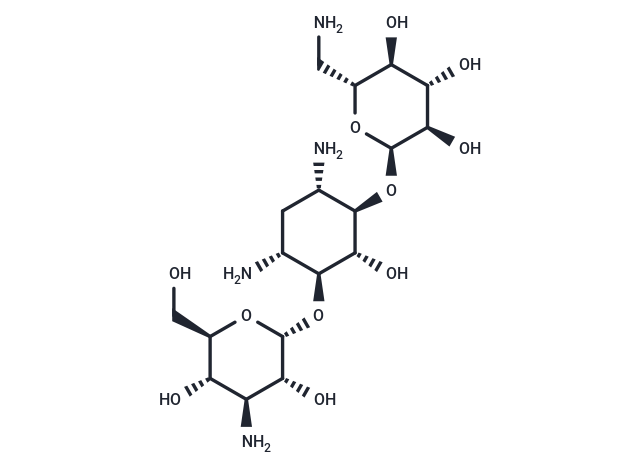Shopping Cart
Remove All Your shopping cart is currently empty
Your shopping cart is currently empty
Kanamycin (Kanamycin A) is an orally administered aminoglycoside antibiotic with antibacterial activity, inhibiting bacterial and viral replication by targeting cellular RNA, used for research on tuberculosis and pneumonia.

| Pack Size | Price | USA Warehouse | Global Warehouse | Quantity |
|---|---|---|---|---|
| 200 mg | $40 | - | In Stock | |
| 500 mg | $61 | - | In Stock |
| Description | Kanamycin (Kanamycin A) is an orally administered aminoglycoside antibiotic with antibacterial activity, inhibiting bacterial and viral replication by targeting cellular RNA, used for research on tuberculosis and pneumonia. |
| In vitro | The concentration of Kanamycin above 0.0025% has a significant inhibition on the growth of B. bifidum while having no influence on the other four probiotics at incubation 12 h or 24 h. The optimum selective concentration of kanamycin in MRS media is 0.005% for selective enumeration of B.bifidum[3]. |
| In vivo | The neurons damage of the DCN induced by kanamycin (500 mg/kg/day) is reversible and autophagy is upregulated in the neurotoxic course of kanamycin on DCN through JNK1-mediated phosphorylation of Bcl-2 pathway in rats. The serum BUN and Cr levels are both increased at the 1st day after the period of kanamycin administration. The neurons expressing LC3 are increased at 1, 7 and 14 days after kanamycin administration in comparison to the control group. Kanamycin treatment results in the increase of autophagy in a time-dependent manner[1]. Kanamycin (5 mg/kg) and sodium ampicillin (10 mg/kg) administered intramuscularly (i.m.) separately, and then together, to five pony mares, and the ampicillin concentration exceeds 5 mg/mL in inflamed synovial fluid for some 2.5 h after injection, and kanamycin concentration exceeds 2 mg/mL for 7 h in the pony[2]. |
| Molecular Weight | 484.50 |
| Formula | C18H36N4O11 |
| Cas No. | 8063-07-8 |
| Smiles | N[C@@H]1[C@@H](O[C@@H]2[C@H](O)[C@@H](O)[C@H](O)[C@@H](CN)O2)[C@H](O)[C@@H](O[C@@H]3[C@H](O)[C@@H](N)[C@H](O)[C@@H](CO)O3)[C@H](N)C1 |
| Relative Density. | no data available |
| Color | White |
| Appearance | Solid |
| Storage | keep away from direct sunlight | Powder: -20°C for 3 years | In solvent: -80°C for 1 year | Shipping with blue ice/Shipping at ambient temperature. | |||||||||||||||||||||||||||||||||||
| Solubility Information | DMSO: < 1 mg/mL (insoluble) H2O: 100 mg/mL (206.4 mM), Sonication is recommended. | |||||||||||||||||||||||||||||||||||
Solution Preparation Table | ||||||||||||||||||||||||||||||||||||
H2O
| ||||||||||||||||||||||||||||||||||||
| Size | Quantity | Unit Price | Amount | Operation |
|---|

Copyright © 2015-2026 TargetMol Chemicals Inc. All Rights Reserved.